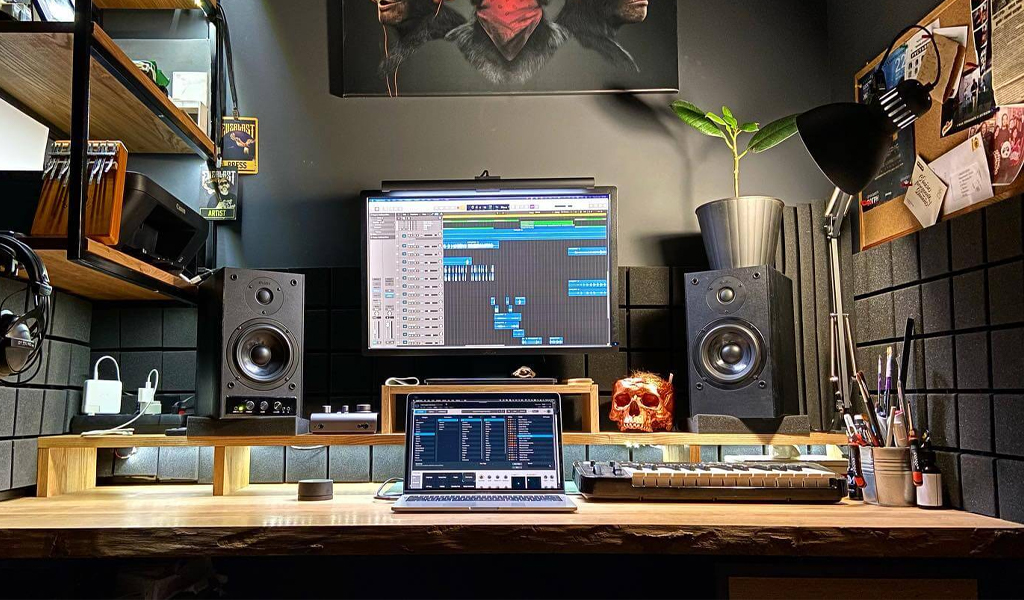
How to Setup a Recording Studio at Home?
????? How to Set Up a Recording Studio at Home: A Beginner’s Guide
Whether you’re a budding music producer, singer-songwriter, podcaster, or content creator, having your own home recording studio can take your creativity to the next level. With today’s technology, setting up a professional-sounding studio at home is more achievable than ever — even on a budget.
In this blog, we’ll walk you through the essential steps and gear you’ll need to build a productive home recording setup.
?
???? Step 1: Choose the Right Space
Start by selecting a quiet, isolated room. A spare bedroom, office, or even a large closet can work well. Ideally, choose a space with minimal external noise and little echo.
Tips:
• Avoid rooms with lots of windows or hard surfaces.
• Add rugs, curtains, or foam panels to reduce sound reflection.
• Don’t overlook comfort — you’ll be spending hours here.
?
????? Step 2: Pick Your Computer
Your computer is the heart of your studio. You don’t need a top-of-the-line machine, but it should have:
• At least 8GB of RAM (16GB is better)
• A modern processor (Intel i5/i7 or Apple M1/M2)
• SSD storage for faster loading times
Mac or Windows? It’s up to your preference, but make sure it’s compatible with the software you plan to use.
?
????? Step 3: Choose a Digital Audio Workstation (DAW)
Your DAW is the software you’ll use to record, edit, mix, and produce your music. Popular options include:
• Logic Pro X (Mac only)
• Ableton Live
• FL Studio
• Cubase
• Pro Tools
• GarageBand (free for Mac users)
• Reaper (budget-friendly and powerful)
Choose one based on your workflow style and genre.
?
????? Step 4: Audio Interface
An audio interface is a device that connects your instruments and microphones to your computer. It converts analog signals into digital data for your DAW.
Top Picks:
• Focusrite Scarlett 2i2
• Universal Audio Volt
• PreSonus AudioBox
• Audient iD4
Look for at least two inputs, phantom power (48V) for condenser mics, and low-latency monitoring.
?
???? Step 5: Get a Good Microphone
You’ll need a quality microphone — especially if you’re recording vocals or acoustic instruments.
Recommended Types:
• Condenser Microphone – Great for vocals and detail-rich recordings (e.g., Audio-Technica AT2020, Rode NT1)
• Dynamic Microphone – Best for podcasts, loud sound sources, or untreated rooms (e.g., Shure SM58, SM7B)
Don’t forget a mic stand, pop filter, and shock mount.
?
???? Step 6: Studio Monitors & Headphones
While consumer speakers may sound nice, they often “color” the sound. Studio monitors provide a flat, accurate audio profile.
Monitors:
• Yamaha HS5/HS8
• KRK Rokit Series
• Presonus Eris
Headphones (for silent monitoring or vocal tracking):
• Audio-Technica ATH-M50x
• Beyerdynamic DT 770 Pro
• Sennheiser HD280 Pro
?
???? Step 7: Cables & Accessories
You’ll need a few basics to connect everything:
• XLR cables for microphones
• TRS cables for monitors
• USB cable for your audio interface
• Power surge protector
• Acoustic foam panels or bass traps (for better sound treatment)
?
????? Step 8: Sound Treatment (Not Soundproofing)
To improve recording and mixing quality, focus on acoustic treatment, not full soundproofing.
Start with:
• Foam or fiberglass panels behind speakers
• Bass traps in corners
• Rugs or carpets on the floor
• Bookshelves and curtains to diffuse sound
?
???? Step 9: Start Recording!
Now that your gear is in place:
1. Install and set up your DAW
2. Connect your audio interface
3. Plug in your mic or instrument
4. Set input levels
5. Hit record!
Begin by testing vocal or instrument tracks, and slowly learn your DAW’s features like EQ, compression, reverb, and multitrack layering.
?
???? Pro Tips for Beginners
• Keep your setup simple at first — you can always upgrade later.
• Learn one DAW deeply rather than hopping between them.
• Watch YouTube tutorials to build your skills faster.
• Save your projects often and back them up.
?
???? Final Thoughts
Setting up a home recording studio isn’t just about buying gear — it’s about creating a space where your creativity can flow freely. Start small, stay consistent, and grow your setup as your skills improve.
Whether you’re producing beats, recording vocals, or tracking a podcast, your home studio can be your personal launchpad to professional-quality content.
?
Ready to build your studio?
Visit your nearest music store or contact specialists like BHARGAVA’S MUSIC DELHI for expert advice and great deals on recording gear


